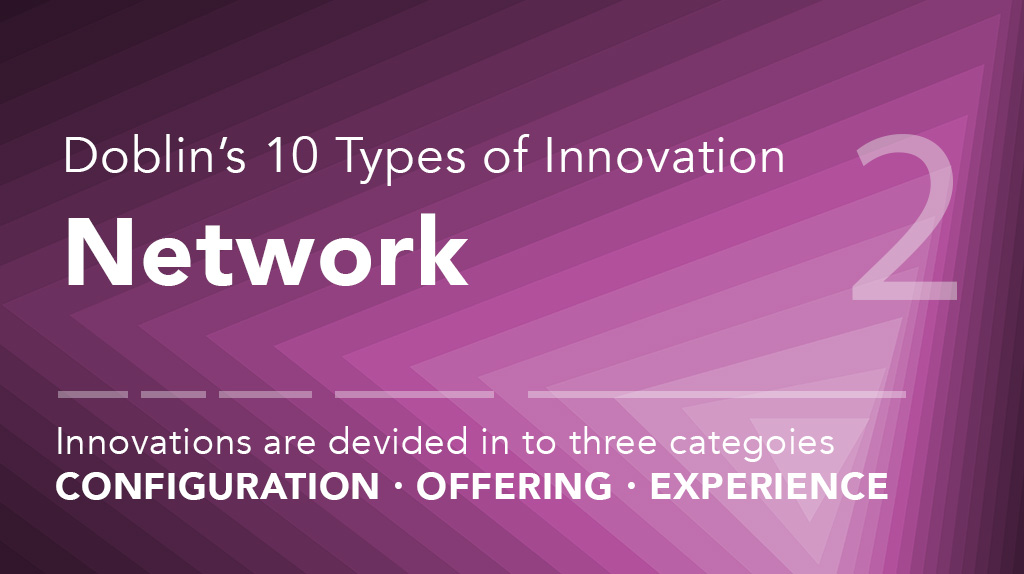Intro
In this series of posts, we will be inspecting Doblin’s 10 Types of Innovation, a popular framework for analyzing innovations in business developed by the Doblin Innovation Firm in Chicago. Innovations are divided into three categories: configuration, offering, and experience. Configuration focuses on the innermost workings of an enterprise and its business system, offering focuses on an enterprise’s core product or service, and experience focuses on customer-facing elements. In this post, we will analyze the second block in configuration, network innovation.
Definition
Network Innovation is essentially about how you create value by connecting with others. Doblin defines network innovation as:
“In today’s hyper-connected world, no company can or should do everything alone. Network innovations provide a way for firms to take advantage of other companies’ processes, technologies, offerings, channels, and brands—pretty much any and every component of a business. These innovations mean a firm can capitalize on its own strengths while harnessing the capabilities and assets of others. Network innovations also help executives to share risk in developing new offers and ventures. These collaborations can be brief or enduring, and they can be formed between close allies or even staunch competitors.”
Examples
Network innovation can take many different forms, the most common of which is open innovation. Open innovation is when multiple companies and/or stakeholders utilize each other’s resources, technology, knowledge, and expertise while also sharing risks and awards with each other. Open innovation approaches also include prize competitions and crowdsourcing, emphasizing problem-solving on a global scale. Other forms of network innovation include creating secondary markets to find alternative consumers, building franchises to license proprietary material, supply chain integrations to lower costs, and alliances like joint ventures. For this blog post, we will primarily focus on open innovation and alliance examples.
Open Innovation
These projects and initiatives eschew the traditional proprietary and secretive R&D labs that companies have in order to foster large-scale collaboration.
P&G’s Connect+Develop Website
Proctor & Gamble is an American multinational consumer goods corporation with subsidiary brands like Gillette, Braun, and more. P&G uses this website in order to connect to and crowdsource innovations from external innovators and companies. Connect+Develop has fostered multiple partnerships as well as products, including a collaboration with OraLabs that made a new lip balm for P&G’s Covergirl brand.
GE’s Ecomagination Project
General Electric is an American multinational conglomerate operating in multiple sectors, including aviation, power, renewable energy, and manufacturing. It launched the Ecomagination project in 2005 in order to embrace crowdsourced innovation and collaborative problem solving from a global network of thinkers, inventors, and industry leaders. In its first ten years, the Ecomagination project has generated more than $200 billion in revenues and helped GE with its PR strategy, allowing it to shed its reputation as one of the world’s biggest polluters.
Freightliner / Department of Energy Supertruck Initiative
Freightliner is an American truck manufacturer that answered the US Department of Energy’s 2009 call for a highly-efficient truck with 50% better freight efficiency and 50% better brake thermal efficiency. Freightliner’s effort combined the network innovations of almost 50 companies, suppliers, and universities. The result was staggering — the final product boasted a 115% fuel efficiency improvement, blowing the efficiency goal out of the water.
MAMMOET Project
MAMMOET, which stands for MAssive MiMO for Efficient Transmission, is a European Commission-sponsored project that aims to enable more efficient mobile data transfers. The EC has partnered with academic, research institute, and industrial partners in order to investigate the practical limits of Massive MiMo as well as develop complete solutions to leverage low-cost and flexible hardware. The MAMMOET Project is a shining example of how open innovation isn’t restricted to just companies, but can also extend to governments and other organizations as well.
Lego Ideas
Lego is a Danish toy company that partnered with Chaordix in order to form the Lego Ideas website, where users can submit ideas for Lego products with the possibility of having them turned into commercially available sets. These sets can be a collaboration of multiple creators, and should a project idea get 10,000 supporters as well as official selection by Lego, the creators are entitled to a 1% royalty fee. To date, Lego has announced 41 sets, 33 of which have been produced, and the Lego Ideas project has been considered groundbreaking in the toy industry.
Alliances
These inter-company alliances, like joint ventures, combine the respective expertise of the companies involved.
Target
Target is an American retail corporation that has an extensive partnering network of product designers and world-renowned fashion designers to create Target-exclusive items. For instance, renowned architect Michael Graves designed a range of kitchen appliances for them, and a five-year collaboration with Isaac Mizrahi created $300 million in annual profits. Not only have these partnerships been immensely profitable, they have helped elevate Target’s brand from its many competitors.
Chrysler
Chrysler is one of the “Big Three” automobile manufacturers in the United States. In the 1970s and 80s, Chrysler was on the verge of bankruptcy when they decided to develop their first minivan, relying on a network of suppliers to bear the cost of R&D for family-friendly features. The minivan was a huge success, helping stabilize the company as well as establishing the minivan as a new major subcategory of automobile.
Hulu
Hulu is an American subscription video on demand service fully controlled and majority-owned by The Walt Disney Company. The service started as a joint venture between NBCUniversal, Providence Equity Partners, News Corporation, and Disney in order to provide a way for consumers to watch recent episodes of television. While this joint venture was necessary in the beginning in order to ensure a certain amount of content to be available, Hulu has since become one of the fastest growing streaming platforms and has expanded into producing its own content.
Caradigm
Caradigm is a US company acquired by Inspirata that develops and offers health management and healthcare analytics software. Caradigm was introduced as a 50/50 joint venture between Microsoft and GE, aiming to integrate Microsoft’s healthcare intelligence product and platform with GE’s healthcare technologies. Caradigm is an example of two massive corporations with differing expertises working together on a project.
Fiat Chrysler and Google
Fiat Chrysler is a multinational automobile corporation and Google is an American multinational technology company that specializes in Internet-related services and products. In 2016, the two companies announced a partnership to develop self-driving cars, marking the first time that Google, the industry leader, was working directly with an automaker to integrate its technology. This partnership is a great example of how companies can share risk, especially on speculative technology like self-driving cars, by working together.
Techniques to Develop Network Innovation
Network innovation can be neglected within industries, and thus can provide a significant opportunity. Larry Keeley, president of Doblin, argues that “if you map out the different types of innovation activity in a given industry, you’ll almost always find that most organizations are concentrating on the same types — they’re all investing in the same things, just to keep up.” If a given industry has been neglecting network innovations, merely starting down that path can be enough to give an edge over competitors.
One can start inspecting the possibilities for network innovations by looking at the core advantages and competencies of one’s own company while thinking about the areas in which the company is currently lacking. Perhaps some competencies can be relevant for future applications that haven’t been developed yet, applications that would require a partner with differing expertise to get off the ground. Then, one can start the search for potential partners with whom one feels their company can innovate with.
Because innovation can be limited to who is around you, social and professional networks are crucial to innovation. At the same time, the more highly networked a company is, the more it is exposed to information leaks that may benefit competitors. Contrary to what companies may think, being more secretive may not be the solution. The Harvard Business Review suggests identifying and nurturing the highly connected “gatekeepers,” the prolific technical contributors who work and communicate with many people within and across disciplines and organizations, in order to maximize innovation while minimizing competitive risk. These gatekeepers are better assessors of competitive risk than managers, due to their understanding of the landscape and relevant technology. If properly encouraged to aggressively build connections outside of their disciplines and industries, they can possibly spark completely new ideas that can lead to unanticipated breakthroughs.
Impact
Network innovations can have significant impacts on bottom lines, efficiency, growth, and entire industries at once. Network innovations are highly economical, since a firm doesn’t need to start from scratch on any given project, and risk is limited since it is shared among stakeholders. Network innovations are also more effective, as a global information distribution network allows firms to employ best tools and techniques, reduce redundancy, and conserve time. Should the project become successful, stakeholders are able to grow and enjoy new sources of revenue, including licensing and selling research data. Finally, groundbreaking projects have the ability to fundamentally change industries as well as create new ones.
However, network innovations does come with a few challenges. A natural consequence of the increased amount of interactions and collaborations is a decrease in the ability to protect intellectual property and proprietary knowledge. Extra capital, time, and labor must be allocated in order to build, maintain, and sustain relationships with partners. An over-dependence on external partners could lead to power imbalances and opportunities for breaches of trust. Finally, at the conclusion of a project, partners that revert to competitors may be better equipped to become more fierce rivals, due to an intimate understanding of shared intel and research data.
At the end of the day, network innovations will most likely help a company rather than hurt them. Cross collaboration and open innovation can have huge effects on a company, at potentially a fraction of the cost if they were to do an entire undertaking by themselves.
Conclusion
As demand from customers grows, companies are being continuously incentivized to expand their innovation “ecosystems.” Network innovation is quickly becoming an integral part of the overall operating strategy of firms, as companies are beginning to understand the limits of how much they can do on their own. Firms partnering together can jointly bring products and services to market much faster than any single company can if they are able to combine their respective expertise.
Companies can take different approaches to network innovations. Some may purchase intel from other firms or acquire it through partnerships, alliances, or licensing. Others will outsource their research and development, depending on their willingness to give up a certain amount of secrecy (dependent on industry). Other approaches include joint ventures, alliances, joint developments, contract R&D, direct purchasing, licensing, investments in universities, and more. What is most important when evaluating how to best take advantage of network innovation is to inspect the overall strategy of your firm. When harnessed correctly, network innovations can unlock innovation, potential, and growth in ways that a single company acting alone could never be capable of.




